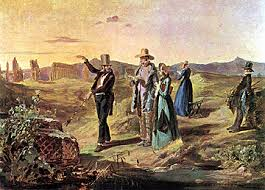
Although advances in steam packets would explode international travel in the mid to late 1800s, the Regency and early Victorian/late Georgian eras still saw some international travel. Wars abroad, including the Napoleanic Wars saw modified travel routes around areas of conflict (Suntikul, 2013). Although the Grand Tour went through a slow down during war time, its resurgence after the wars into the early Victorian era also ushered in “a more formalized tourist industry” (Towner, 1985, p.297).
The Grand Tour is typically talked about as an exclusively male activity, but frequently women and children would accompany gentlemen on their travels (https://www.york.ac.uk/media/eighteenth-century/cecsatthekingsmanor/Conference%20Abstracts.pdf). For an inspirational article about trailblazing women travelers: https://www.theguardian.com/travel/2016/mar/08/top-10-inspiring-female-travel-adventurer or there is this post about women travelers: https://www.rbkc.gov.uk/leightonarabhall/travel2.html. We also did a post several years ago on Lady Hester Stanhope.
Limited travel abroad saw more activity in the U.K., with visitors flocking to not only Spa Towns but also far flung locations (at least by a carriage) like Scotland and Wales. Limited travels also took place the U.S.A., Canada, Central and South America, Ireland, and the West Indies. For women traveling during the 19th century outside of the UK, I recommend the book Women, Travel, and Science in Nineteenth Century Americas (citation below) which focuses on the travel writer Frances Calderon de la Barca (nee Erskine Inglis) who was well known for her 1843 book Life in Mexico and Elizabeth Cabot Agassiz, an American naturalist and writer who traveled to Brazil.
Travelling generally around the world boomed during the early to late Victorian era. According to Stowe (1994), “many nineteenth-century Americans traveled, and many more participated vicariously in the experience of travel by reading travel letters, sketches, and narratives in newspapers, magazines, and published volumes” (p. 3). Similarly, the appetite for travel in the U.K. was also voracious and included print media when travel was not possible. Railroads made local, regional, and UK travel more accessible and affordable, with quicker speeds.
Take the Grand Tour Online: http://www.umich.edu/~ece/student_projects/grandtour_tourism/grandtour.html
Read about the Grand Tour:
https://www.regencyhistory.net/2013/04/the-grand-tour.html
https://janeaustensworld.wordpress.com/2008/04/14/the-grand-tour-in-the-18th-19th-century/
https://www.bl.uk/picturing-places/articles/a-royal-armchair-traveller-the-grand-tour-and-the-kings-topographical-collection
Gerassi-Navarro, N. (2018). Women, Travel, and Science in Nineteenth-Century Americas: The Politics of Observation. (n.p.): Springer International Publishing.
MELISH, J. (1818). Travels through the United States of America, etc. United Kingdom: J. Smyth.
Stowe, W. (1994). Going Abroad: European Travel in Nineteenth-Century American Culture. PRINCETON, NEW JERSEY: Princeton University Press. doi:10.2307/j.ctt1m3nzrr
Suntikul, W. (2013). Tourism and War. United Kingdom: Taylor & Francis.
Towner, J. (1985). The Grand Tour: A key phase in the history of tourism. Annals of Tourism Research, Voume 12, Issue 3, pp. 297-333.









